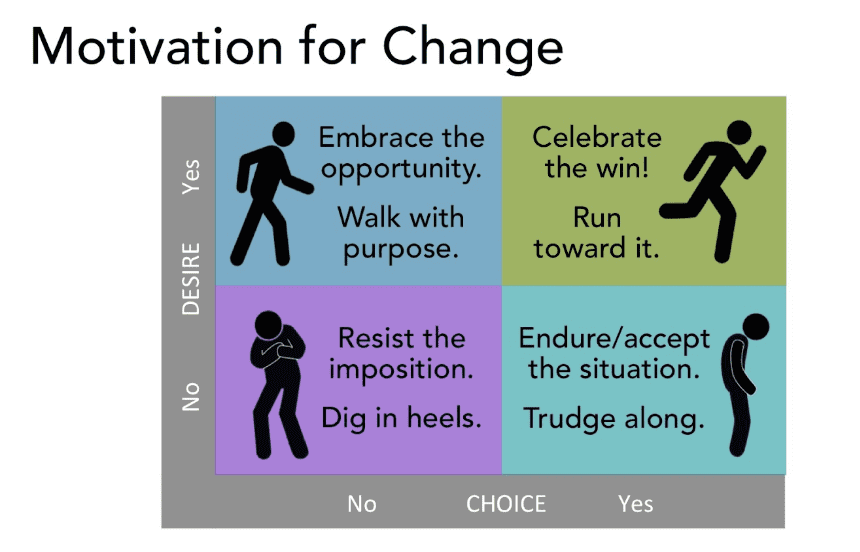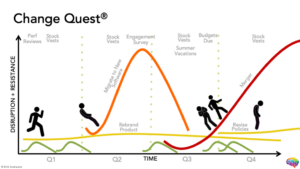How Great Leaders and Managers Can Motivate Employees Through Change

While we are an adaptive species, we are oddly wired to resist change. The brain (specifically the amygdala) sees a change in our environment as a warning sign of potential danger and only settles down when no real threat is found. Change is the lion lurking in the tall grass-if we see it, we can protect ourselves and if we miss those important telltale signs… well, we're lunch.
If you think about it, we are all the descendants of people with highly tuned amygdalas who heeded the warning signs and lived another day. We are here because our predecessors paid attention to change, were cautious, and did their due diligence before relaxing.
This same phenomenon plays out every day in workplaces around the world. In our modern times, change at work stills represents a threat. Maybe not to our lives but certainly to our livelihood-things that matter to us like our paychecks, our network of trusted colleagues, and our ability to make a difference. When a change initiative gets announced, what many leaders and managers want to happen is that employees jump onboard and get to the business of executing the plan.
But instead, they get a wide range of emotional and behavioral responses. They get resistance. When I work with leaders and managers, I always say, "Your people are not being difficult. They are being human."
Great leaders and managers understand this, that every change initiative is perceived as that lion in the grass, and they work with their people to move through their natural resistance in a productive and forward way.
Here are some tips and strategies from Change Quest, the brain-based approach to leading change.
1. Assess the Change and Your People's Motivation
Not all change is created equal nor are all employees motivated in the same ways. Your first step is to assess what kind of change you're asking people to go on. Employees experience change as a function of how long it takes and how disruptive it is to their current ways of working. This can give you four possible types of change; I call them change journeys and liken them to hiking or mountain climbing.
- The Long and Intense Climb will be highly disruptive over a long period of time
- The Quick Hike Up a Steep Hill is highly disruptive but compressed in time, asking people to sprint
- The Long, Steady Trek is not very disruptive but unfolds over a long time
- The Pebble on the Path is quick and easy so is essentially a non-event
In addition to the journey you are asking people to go on, they also have their motivation for that change, which is a matrix of their choice and desire and creates four quadrants of motivation. These represent the energy and attitudes they will bring to the change journey.

Once you map out what you are asking people to do and when, and you add their levels of motivation, you can now have an accurate understanding of what your employees experience and the kinds of leadership skills you need to get them through it successfully.

2. Help Your Group Navigate the Journey
Great leaders and managers always share why the change is occurring, painting a clear and compelling picture of what the organization and employees stand to gain. They also clearly outline the destination, the route, and milestones along the way. This helps employees start to focus on what good may come and can lessen their worry about potential losses/threats.
The best change leaders and managers also think about what behaviors or habits employees need in order to be successful in making the transition and thriving in the new state after the change is completed.
Charles Duhigg, in his book The Power of Habit, shares lots of studies on how to change old habits and build new ones. This is one of the core components of leading successful change and yet very few change plans include this critical process. Neurologically, it takes 40 to 50 repetitions, on average, for a habit to be formed. One of the reasons change initiatives fail is that people have not sufficiently developed the skills and well-grooved habits. You'll want to intentionally build learning into your plan and support employees in changing their behaviors and grooving those new habits through repetition.
3. Motivate People with the Right Rewards
The Change Quest® offers tools to motivate your travelers. Motivation is very important for combatting the brain's natural resistance to change. Unless you're blessed with a group that has high choice and desire for the change, you will need to use various forms of recognition and rewards.
Since recognition is a type of reward that the brain responds well to, a key way to motivate your travelers is to acknowledge both effort and progress as. During a change journey, you will have lots of opportunities to recognize effort and progress-doing so will give your team a boost. This can be especially helpful for the travelers who did not want or choose the change and might be trudging along or digging in their heels. The more their effort is rewarded, the more likely structures in the brain (like the basal ganglia and habenula) will respond in ways that assist the change journey.
But don't ignore your walkers and runners if you are blessed to have them. They will also benefit from recognition, giving them a boost that may energize the entire group. In fact, in a report by Globoforce, researchers found that employee recognition boosted engagement, retention, wellness, safety, and employer brand.
You can recognize your travelers in many different ways. Certainly, a word from you, their leader, is powerful so don't underestimate the power of your praise. According to Dr. Donald Clifton, co-author of How Full Is Your Bucket, not feeling appreciated is the number one reason employees leave a job. In addition, a study by Deloitte found that organizations with effective employee recognition programs had 31 percent less turnover than those with ineffective ones.
Since being recognized by peers also matters, you can create opportunities for that to happen, perhaps in meetings about the change journey. See if you can create a culture where everyone is on the lookout for effort and/or improvement. Look for websites and apps to try, or even go old school with high fives and gold stars if that works for your culture and context.
4. Communicate and Celebrate Progress
Great change leaders and managers understand the value of celebrating progress. Like any journey, your team needs to know where they are on the map, what they have already completed, and what's coming next. Consider climbing expeditions to Everest or the Tour de France-every inch of the process is mapped out and teams spend evenings discussing what happened during the day and plotting their strategy for the next. Climbers and cyclists need to know this information so they can manage their energy and make the right choices with food and hydration, or even when and how to nurse an injury. Your employees are no different.
By communicating regularly about the roadmap and their progress, you empower employees to become active participants in the journey. Also, progress needs to be celebrated! As your team crosses the milestones of the change journey, be sure you acknowledge each and every one with some sort of recognition. Even if you are behind schedule or over budget, you must find ways to mark progress and celebrate. Otherwise, the habenula is likely to code the experience a "failure" and your travelers will become resistant to future change initiatives.
This doesn't mean that you don't have honest conversations about performance and quality. You must have those too. But also be sure you build in moments that let people know they're making progress even though you're not there yet. Too many leaders give too much weight to the constructive and critical feedback and bypass the celebrations because they are busy or behind, leaving the brain with nothing to interpret as a reward.
Want to have more tools like these?
Bring the Change Quest learning solution to your organization. With strategies for senior leaders, managers, and employees, it drives successful change across your entire organization by giving every person clear steps to play their part.
Related Blogs
JOIN OUR COMMUNITY
Be the first to know of Dr. Britt Andreatta's latest news and research.





